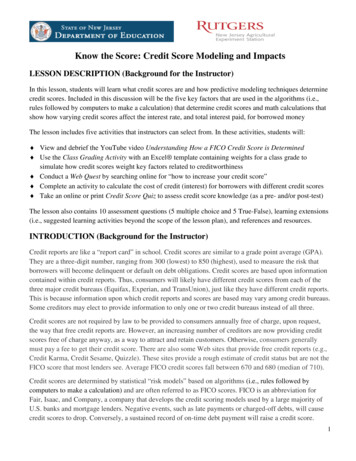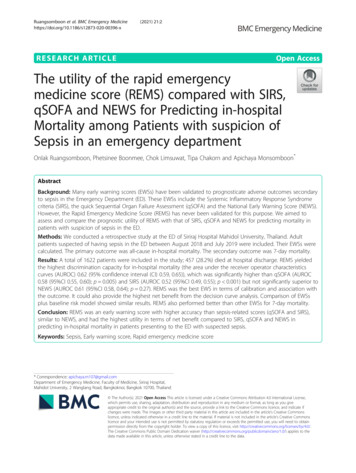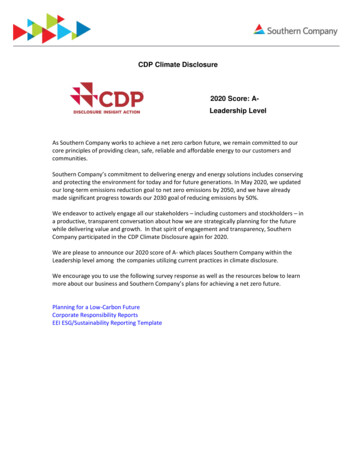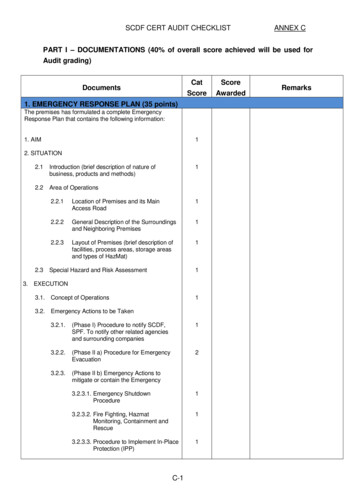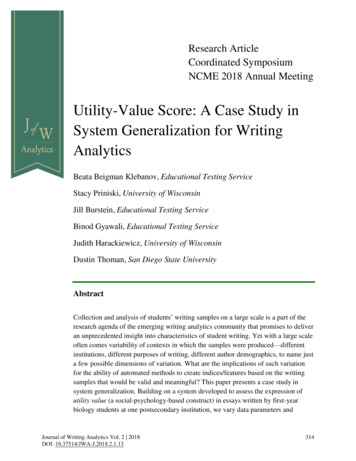
Transcription
Research ArticleCoordinated SymposiumNCME 2018 Annual MeetingUtility-Value Score: A Case Study inSystem Generalization for WritingAnalyticsBeata Beigman Klebanov, Educational Testing ServiceStacy Priniski, University of WisconsinJill Burstein, Educational Testing ServiceBinod Gyawali, Educational Testing ServiceJudith Harackiewicz, University of WisconsinDustin Thoman, San Diego State UniversityAbstractCollection and analysis of students’ writing samples on a large scale is a part of theresearch agenda of the emerging writing analytics community that promises to deliveran unprecedented insight into characteristics of student writing. Yet with a large scaleoften comes variability of contexts in which the samples were produced—differentinstitutions, different purposes of writing, different author demographics, to name justa few possible dimensions of variation. What are the implications of such variationfor the ability of automated methods to create indices/features based on the writingsamples that would be valid and meaningful? This paper presents a case study insystem generalization. Building on a system developed to assess the expression ofutility value (a social-psychology-based construct) in essays written by first-yearbiology students at one postsecondary institution, we vary data parameters andJournal of Writing Analytics Vol. 2 2018DOI: 10.37514/JWA-J.2018.2.1.13314
Utility-Value Scoreobserve system performance. From the point of view of social psychology, all thesevariants represent the same underlying construct (i.e., utility value), and it is thus verytempting to think that an automatically produced utility-value score could provide ameaningful analytic, consistently, on a large collection of essays. However, findingsfrom this research show that there are challenges: Some variations are easier to dealwith than others, and some components of the automated system generalize betterthan others. The findings are then discussed both in the context of the case study andmore generally.Keywords: automated writing evaluation, data variability, first-year STEM, model evaluation,model generalization, STEM motivation. student writing, utility value, writing analytics1.0 Introduction: Data Variability as a Challenge for Large Scale AnalyticsThe concept of analytics—meaningful information derived from large-scale data—embodiestension between the increasingly abundant raw data on the one hand and the cost of labor forinterpreting the raw data in order to derive analytic indices of interest on the other. In aneducational context, for example, it is possible to collect a large number of writing samples thatcan be used to answer questions such as “What genres of writing are represented in thecollection?” or “To what extent do the samples adhere to the writing conventions of English?”.In order to do this, a systematic analysis of the raw data needs to be conducted to create genrelabels or scores for adherence to English writing conventions. Asking humans to perform suchanalyses on a large scale is time-consuming and costly. One way to resolve the cost-vs-scaleissue is to combine human and machine “labor” for the large-scale analysis: Humans couldprovide labels to a small subset of the data, and machine learning would be applied to build anautomated system that would extend the labeling to the larger dataset.An important question that arises in this context is that of the validity of the automaticallyproduced label. A development plan for an automated system would typically include anevaluation step: A subset of the human-labeled data is deliberately set aside and not used fortraining the system so that the system can be tested on this new, unseen data. Yet, theaccumulation of data for large scale analytics is often dynamic—more data is added in anongoing, real-time fashion; the question then becomes that of the appropriateness of theautomated system that was designed using an early sample for analyzing the incoming data.These new, incoming data might be produced in contexts that are similar but not identical to theearlier sample, in such terms as demographics of the writer population or purpose of writing.This paper presents a case study in system generalization—specifically, how utility-valuescoring models built using one data set generalize to new datasets with varying characteristics.Building on a system originally developed to assess the expression of utility value in essayswritten by first-year biology students in one postsecondary institution, we vary data parameters,specifically, institution, subject matter, and a detail of the target construct, and observe systemperformance. From the point of view of social psychology, all these variants represent the sameJournal of Writing Analytics Vol. 2 2018315
Beigman Klebanov, Priniski, Burstein, Gyawali, Harackiewicz, & Thomanunderlying construct (i.e., utility value), and it is thus very tempting to think about anautomatically produced utility-value score as a meaningful analytic on a large collection ofessays. However, we show that this endeavor is not without challenges, as some variations areeasier to deal with than others, and some components of the automated system generalize betterthan others. We discuss the findings both in the context of the case study and more generally.2.0 Utility-Value Intervention (UVI)2.1 BackgroundKeeping students interested in science courses is crucial to retaining them in STEM majors andon track for STEM careers. One way to develop interest in activities is to find meaning and valuein those activities (Durik & Harackiewicz, 2007; Hidi & Harackiewicz, 2000). Grounded inexpectancy value theory (Eccles & Wigfield, 2002), the utility-value intervention (UVI) aims topromote student motivation and performance by having students reflect on the value of what theyare learning. In other words, the UVI seeks to help students focus on the personal relevance andusefulness of the course material, giving them a reason to learn the material (because it isrelevant and useful), and therefore increasing their motivation to engage with the material andthe likelihood that they will perform well in the course. The intervention typically involveswriting assignments, integrated into the curriculum as homework and completed for coursecredit. In the control conditions, students summarize a topic they've been learning about. In theutility-value conditions, students summarize a topic and explain how the topic is relevant oruseful in their own or others' lives. Thus, the assignments all have curricular value, but theutility-value assignments have the added benefit of helping students to find value in what theyare learning.A growing body of evidence suggests that the UVI is effective in science courses. Early testsof the intervention improved grades and interest among high school science students with lowexpectations of success in their science course (Hulleman & Harackiewicz, 2009) and improvedinterest among college psychology students with a history of poor performance (Hulleman,Godes, Hendricks, & Harackiewicz, 2010). More recent tests of the intervention have foundpositive effects on performance in college biology and psychology courses for all students, onaverage (Canning, Harackiewicz, Priniski, Hecht, Tibbetts, & Hyde, 2018; Harackiewicz,Canning, Tibbetts, Priniski, & Hyde, 2016; Hulleman, Kosovich, Barron, & Daniel, 2017), andespecially for students with a history of poor performance (Harackiewicz et al., 2016; Hullemanet al., 2017). The UVI has even helped to close achievement gaps for underrepresentedracial/ethnic minority students who were also first-generation college students (Harackiewicz etal., 2016). Finally, initial tests of UVI effects on students' STEM pursuits suggest that theintervention can have positive effects on students' intent to major in STEM fields (Canning et al.,2018; Hulleman et al., 2010).Given the growing evidence of effectiveness, interest in the UVI is growing among STEMeducators and researchers alike. However, the intervention takes a great deal of human labor toJournal of Writing Analytics Vol. 2 2018316
Utility-Value Scoreimplement. First, because the intervention is integrated into the curriculum as courseassignments, the assignments need to be evaluated. In a large introductory course, typically withthree assignments across the semester, this requires hundreds of hours of grading labor. Thegrading can be done by professors, teaching assistants, or paid reader-graders, but a certain levelof expertise is required. Ideally, graders understand the course material well enough to givefeedback on the scientific content of the assignments, and understand the concept of utility valuewell enough to give students in the utility-value conditions feedback on the utility-value content.Thus, graders typically require training to be able to recognize high-quality utility-valueconnections and give formative feedback when such connections are lacking. The utility-valuefeedback is important because science students may not be used to including personal content intheir science writing assignments and may require some additional supports to understandwhether they are meeting expectations in this regard.In addition to the grading labor, researchers who implement the UVI typically code theassignments for the quality of the utility-value content, in order to assess implementation fidelityas well as gain insight into the mechanisms driving the effectiveness of utility-value writing. Inthe cases of the largest field tests of the UVI to date (Canning et al., 2018; Harackiewicz et al.,2016), this coding involved evaluating each assignment on how personal and specific the utilityvalue content was, on a 0–4 scale. This coding was conducted by a team of 10–15 undergraduateresearch assistants, working approximately eight hours/week throughout the semester. Thetraining for these research assistants involved group and individual instruction over the course of2–3 weeks, during which the research assistants learned the coding scheme, coded a training setof assignments, and received individual feedback on the accuracy of their coding until theydemonstrated mastery. Each assignment was coded by 2–3 coders, and a master coder thencompared coders' scores and resolved any disagreements.In sum, the UVI as typically implemented requires a significant labor investment, both on thepart of the instructional team and the research team. Indeed, the labor investment is likelyprohibitive for many instructors who might want to implement the assignment but cannot add somany grading hours to their own (or their instructional staff's) workload. Thus, if the interventionis to be implemented at scale, it will be necessary to develop a less labor-intensive way toevaluate the content of the assignments and give students the necessary feedback to ensuresuccessful and effective implementation of the intervention.Our previous work with assignments from the Harackiewicz et al. (2016) study suggests thatnatural language processing (NLP) may provide a useful tool to automate some of the contentevaluation process (Beigman Klebanov, Burstein, Harackiewicz, Priniski, & Mulholland, 2017;Beigman Klebanov, Burstein, Harackiewicz, Priniski, & Mulholland, 2016). However, usingsuch tools at scale would require them to be flexible to implementation of the UVI acrosscourses, contexts, and variations of the utility-value assignments. The current paper is the firsttest of whether previously-developed models and linguistic indicators of utility value cangeneralize across multiple implementations of the UVI.Journal of Writing Analytics Vol. 2 2018317
Beigman Klebanov, Priniski, Burstein, Gyawali, Harackiewicz, & ThomanThe study leverages data collected from UVI studies conducted at California StateUniversity-Long Beach, University of Wisconsin-Madison, and at several two-year campuses ofthe University of Wisconsin Colleges system. We present a series of experiments designed toevaluate generalization of models and linguistic indicators of utility to (a) data from a differentinstitution; (b) data from a different subject (biology vs. psychology); (c) data written in responseto a slightly modified utility-value task (personal vs. community utility).2.2 UVI Tasks and Scoring Rubric2.2.1 UVI task in institutions A and B. This assignment was administered to introductorybiology students at institution A and introductory biology and psychology students at institutionB.Assignment: Select a concept or issue that was covered in lecture and formulate aquestion (see examples at the end of this document). This question should bestated explicitly in your assignment, either as the title or in the first paragraph.Select the relevant information from class notes and the textbook, and write a500-600 word essay (double-spaced).Write an essay addressing this question and discuss the relevance of the conceptor issue to your own life.1 Be sure to include some concrete information that wascovered in this unit, explaining why this specific information is relevant to yourlife or useful for you. Be sure to explain how the information applies to youpersonally and give examples.Students were given examples of UV connections, relevant to the current course topics. Thefollowing were given as examples of the part of an essay that explains personal usefulness:Biology: “This week we've been talking about osmosis in class and I finallyrealized why my dad told me once to use honey when I cut myself shaving, sincewe were out of Neosporin. I thought this was weird until I learned about osmosisand how honey can work as an anti-bacterial ointment, because the sugar to waterconcentration in the honey is so large that no bacteria can survive. Honey is justone example of how important osmosis is to my life.”Psychology: “Learning about classical conditioning finally made me understandhow I developed a fear of bees. I was stung by a bee at a park when I was little.The next year I was stung by a bee again. Both times it really hurt. After that, Ibecame scared of bees. Now I know that the bee was a conditioned stimulus, thesting was an unconditioned stimulus and the fear was the conditioned response. Inorder to overcome my fear of bees, I need to associate bees with something1 Some students were administered a slightly modified version of the task, with this sentence being: “Write an essay addressingthis question and discuss how the information could be useful to you in your own life.”'Journal of Writing Analytics Vol. 2 2018318
Utility-Value Scorepositive. If I eat candy every time I see one, then the unconditioned stimulusbecomes the candy and my happiness becomes the conditioned response.”2.2.2 UV task in institution C data. This writing assignment was administered to studentsin 1st year biology, chemistry, and physics at institution C.Assignment: Select a concept or issue that was covered in lecture and formulate aquestion. This question should be stated explicitly in your assignment, either asthe title or in the first paragraph. Select the relevant information from class notesand the textbook, and write a 1-2 page essay.Write an essay addressing this question and discuss the relevance of the conceptor issue to helping a community to which you belong. Be sure to include someconcrete information that was covered in this unit, explaining why this specificinformation is relevant to, or useful for, helping your community. Be sure toexplain how the information is useful and give examples.Since you will be writing about science from a personal perspective, you shouldgive personal examples and can use personal pronouns (I, we, you, etc.). You donot need to provide citations.The following were given as examples of the part of an essay that explains usefulness tocommunity:Biology: “When I learned about plant diversity in this course, I found out thatsome plants are more prone to pests than others. Information about plants andtheir genetics could allow me to know the best ways to control pests. Forexample, in my textbook I learned about Bacillus thuringienis, which is abacterium that allows for natural resistance against insects in crops. Crops thathave resistance against pests could lead to greater food preservation and lower thecost of foods. Now that I have learned more about plant breeding andbiotechnology, I think that this information could be used to help people from myown community to have greater access to affordable fresh vegetables and fruits.”Chemistry: “When I learned about chemical bonding in this course, I found outthat different materials have different properties. Metal materials are held togetherwith metallic bonding, which have good conduction of electricity, malleability,and ductility. Although, metals are very sturdy and can be used for transfer ofelectricity in a home, they are also relatively expensive. By better understandingionic bonds, which incorporate metals and nonmetals, we can test physicalmaterials that are sturdy and more cost-effective. Now that I’ve learned moreabout chemical bonding, I think that this information could be used to help peoplefrom my own community to have more affordable housing."Journal of Writing Analytics Vol. 2 2018319
Beigman Klebanov, Priniski, Burstein, Gyawali, Harackiewicz, & ThomanPhysics: “When I learned about momentum in this course, I found out thatmomentum can be transferred or conserved during motion. I also now know thatchanges in momentum usually signals a change in velocity. By betterunderstanding how to keep trains at a certain velocity, we can learn how to buildmore energy efficient trains. More energy efficient public transportation systems,like trains, could lower the cost of transportation. Now that I have learned moreabout momentum, I think that this information could be used to help people frommy own community to have more affordable public transportation.”2.3 UV Scoring RubricThe utility-value writing assignments were coded by research assistants for the levelof utility value articulated in each essay, on a scale of 0–4, based on how specific and personalthe utility-value connection was to the individual. Table 1 shows the rubric.Table 1Utility-Value Coding Rubric2UV scoreExplanationExample0No UVThis is how muscles work.1Non-personal UVIt is important to understand howmuscles work.2Personal UV, but generic and/or broad, could apply toanyoneI use muscles to move and stay alive.3Personal UV with specific connection to a person's lifeMy friend uses muscles to play soccer.4Personal UV with specific connection to a person's life andapplication, elaboration, or explanation of how thatconnection mattersNow that I know how muscles build, Iknow how to optimally train for soccer.According to Harackiewicz et al. (2016), inter-rater agreement for this coding rubric ishigh: Two raters provided the exact same score for 91% of the essays. Disagreements wereresolved by a master coder following a discussion, if needed. Students were given five days tocomplete the assignment. Each student contributed three writing samples. This rubric was used atinstitutions A and B.For the data collection at institution C, the rubric was modified somewhat to address utilityfor a specific community rather than a specific individual. Thus, “Knowledge about plantdiversity could help with food preservation in my community” would be given a score of 2, sincethe specified utility could apply to any community. In contrast, the following would be given a2 Personal utility may apply to the writer or any other specific “named” individual mentioned in the essay; “personal” utility isnot restricted to utility for the self.Journal of Writing Analytics Vol. 2 2018320
Utility-Value Scorescore of 4, since the description provides a specific and elaborated connection to the person'scommunity: “My community is facing a severe drought and this causes the price of certain freshfoods to ris
model generalization, STEM motivation. student writing, utility value, writing analytics 1.0 Introduction: Data Variability as a Challenge for Large Scale Analytics The concept of analytics—meaningful information derived from large-scale data—embodies tension between the increasingly ab
